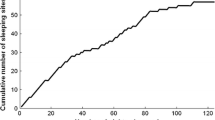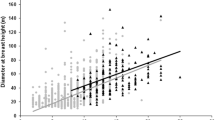Summary
Central place foraging models assume that animals return to a single central place such as a nest, burrow, or sleeping site. Many animals, however choose between one of a limited number of central places. Such animals can be considered Multiple Central Place Foragers (MCPF), and such a strategy could reduce overall travel costs, if the forager selected a sleeping site close to current feeding areas. We examined the selection of sleeping sites (central places) by a community of spider monkeys (Ateles geoffroyi) in Santa Rosa National Park, Costa Rica in relation to the location of their feeding areas. Spider monkeys repeatedly used 11 sleeping trees, and they tended to choose the sleeping site closest to their current feeding area. A comparison of the observed travel distances with distances predicted for a MCPF strategy, a single central place strategy, and a strategy of randomly selecting sleeping sites demonstrated (1) that the MCPF strategy entailed the lowest travel costs, and (2) that the observed travel distance was best predicted by the MCPF strategy. Deviations between the observed distance travelled and the values predicted by the MCPF model increased after a feeding site had been used for several days. This appears to result from animals sampling their home range to locate new feeding sites.
Similar content being viewed by others
References
Altmann J (1974) Observational study of behavior: Sampling methods. Behaviour 49:227–265
Andersson M (1978) Optimal foraging area: Size and allocation of search effort. Theor Pop Biol 13:397–409
Andersson M (1981) Central place foraging in the whinchat Saxicola rubetra. Ecology 62:538–544
Armitage KB (1988) Resources and social organization of grounddwelling squirrels. In: Slobodchikoff CN (ed) The Ecology of Social Behaviour. Academic Press, New York, pp 131–155
Brooke ML (1981) How an adult wheatear (Oenanthe oenanthe) uses its territory when feeding nestlings. J Anim Ecol 50:683–696
Caccamise DF, Morrison DW (1986) Avian communal roosting: Implications of diurnal activity centers. Am Nat 128:191–198
Caldelott JO (1986) An ecological and behavioural study of the pig-tailed macaque Cont Primatol 21:1–259
Carlson A, Moreno J (1982) The loading effect in central place foraging wheatears (Oenanthe oenanthe L.). Behav Ecol Sociobiol 11:173–183
Chapman CA (1988) Patch use and patch depletion by the spider and howling monkeys of Santa Rosa National Park, Costa Rica. Behaviour 150:99–116
Covich AP (1976) Analysing shapes of foraging areas: Some ecological and economic theories. Ann Rev Ecol Syst 7:235–257
Fleming TH (1982) Foraging strategies of plant-visiting bats. In: Kunz TH (ed) Ecology of Bats. Plenum Press, New York, pp 287–325
Giraldeau L-A, Kramer DL (1982) The marginal value theorem: A quantitative test using load size variation in a central place forager, the eastern chipmunk, Tamias striatus. Anim Behav 30:1036–1042
Hamilton WJ, Watt KEF (1970) Refuging. Ann Rev Ecol Syst 1:263–286
Hobson ES (1972) Activity of Hawaiian reef fishes during the evening and morning transition between daylight and darkness. Fisheries Bull 70:715–740
Horn HS (1968) The adaptive significance of colonial nesting in the Brewer's Blackbird (Euphagus cyanocephalus). Ecology 49:682–694
Janzen DH (1986) Guanacaste National Park: Tropical, ecological, and cultural restoration. Editorial Univ. Estatal a Distancia, San Jose, Costa Rica
Kacelnick A (1984) Central place foraging in starlings (Sturnus vulgaris). I. Patch residence time. J Anim Ecol 53:283–299
Kinzey WG, Rosenberger AL, Heisler PS, Prowse DL, Trilling JS (1977) A preliminary field investigation of the yellow handed titi monkey, (Callicebus torquatus torquatus), in northern Peru. Primates 18:159–181
Klein LL (1972) The ecology and social organization of the spider monkey Ateles belzebuth. Ph.D. Dissertation, University of California, Berkeley
Klein LL, Klein DJ (1977) Feeding behaviour of the Colombian spider monkey. In: Clutton-Brock TH (ed) Primate Ecology. Academic Press, London, pp 153–181
Kramer DL, Nowell W (1980) Central place foraging in the eastern chipmunk, Tamias striatus. Anim Behav 28:772–778
McLaughlin RL, Montgomeric RD (1989) Brood dispersal and multiple central place foraging by Lapland longspur parents. Behav Ecol Sociobiol (in press)
Morrison DH (1983) Artibeus jamaicensis. In: Janzen DH (ed) Costa Rican Natural History. Univ. of Chicago Press, Chicago, pp 449–451
Neyman PF (1978) Aspects of the ecology and social organization of free-ranging cotton-top tamarins (Saguinus oedipus) and the conservation status of the species. In: Kleiman DG (ed) The Biology and Conservation of the Callitrichidae. Smithsonian Inst. Press, Washington, pp 39–71
Orians GH, Pearson NE (1979) On the theory of central place foraging. In: Horn DJ, Mitchell RD, Stairs GR (eds) Analysis of Ecological Systems. Ohio University Press, Ohio, pp 155–177
Parson PE, Taylor CR (1977) Energetics of brachiation vs walking: A comparison of a suspended and inverted pendulum mechanism. Physiol Zool 50:182–188
Peters RH, Cloutier S, Dube D, Evans A, Hastings P, Kaiser H, Kohn D, Sawer-Foner B (1988) The ecology of the weight of fruit on trees and shrubs in Barbados. Oecologia 74:612–616
Rasmussen DR (1979) Correlates of patterns of range use of a troop of yellow baboons (Papio cynocephalus). I. Sleeping sites, impregnable females, births, and male emigrations and immigrations. Anim Behav 27:1098–1112
Schoener TW (1979) Generality of the size-distance relation in models of optimal feeding. Am Nat 114:902–914
Sigg H, Stolba A (1981) Home range and daily march in a hamadryas baboon troop. Folia Primatol 36:40–75
Stephens DW, Krebs JR (1986) Foraging Theory, Princeton University Press, Princeton
Tinbergen JM (1981) Foragig decisions in starlings (Sturnus vulgaris). Ardea 60:1–67
Author information
Authors and Affiliations
Rights and permissions
About this article
Cite this article
Chapman, C.A., Chapman, L.J. & McLaughlin, R.L. Multiple central place foraging by spider monkeys: travel consequences of using many sleeping sites. Oecologia 79, 506–511 (1989). https://doi.org/10.1007/BF00378668
Received:
Issue Date:
DOI: https://doi.org/10.1007/BF00378668




